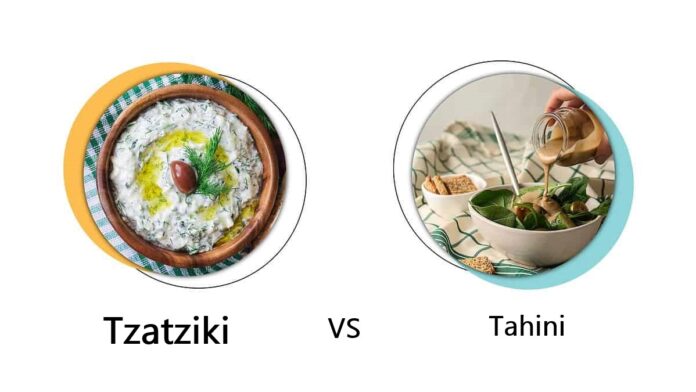Tahini vs Tzatziki: Mediterranean cuisine is a treasure trove of flavors and condiments, and among its most cherished are Tahini and Tzatziki. These two Mediterranean dips, although often mistaken for one another due to their creamy appearance, bring distinct tastes, textures, and culinary possibilities to the table. In this comprehensive guide, we’ll explore the rich world of Tahini and Tzatziki, delving into their unique flavor profiles, textures, and versatile uses.
Tahini: A Delectable Sesame Sensation
Let’s begin our culinary journey by taking a closer look at Tahini.
What Exactly is Tahini?
Tahini is a velvety paste crafted from ground sesame seeds. This humble yet versatile condiment has its origins deeply rooted in Middle Eastern and Mediterranean culinary traditions, dating back centuries. Despite its simplicity, it possesses a complex and intriguing flavor.
The Origins and Cultural Significance of Tahini
Tahini’s history is as rich as its flavor. It has been a staple in Middle Eastern cuisine for centuries, revered for its versatility and nutritional value. This creamy sesame paste has played a significant role in the culinary traditions of countries like Lebanon, Greece, and Israel.
Beyond its culinary significance, Tahini holds cultural importance in many Middle Eastern communities. It is often used in celebratory dishes and symbolizes hospitality and togetherness. Understanding this cultural context adds depth to our appreciation of Tahini.
The Flavor Profile of Tahini
Tahini boasts a unique and enticing flavor that sets it apart from other condiments. It offers a delicate balance of nuttiness, earthiness, and a subtle bitterness, which is derived from the toasted sesame seeds used in its preparation. The bitterness is a part of what makes Tahini so intriguing; it’s a flavor that gradually unfolds on the palate.
Texture Matters: Creamy Elegance
One of the defining characteristics of Tahini is its smooth and luscious texture. When prepared, it transforms into a velvety paste that can be drizzled, dipped, or used as a base for various dishes. This creamy quality makes it a versatile addition to both sweet and savory recipes.
Tahini in Action
Now that we’ve uncovered the essence of Tahini, let’s explore how it’s commonly used in culinary creations:
1. Hummus: The Creamy Foundation
Tahini plays a starring role in the beloved Middle Eastern dip, hummus. It adds depth and creaminess to the chickpea-based dish, contributing to its irresistible texture and nutty flavor.
2. Salad Dressings: Creamy, Nutty Goodness
Tahini is often employed as a key ingredient in salad dressings, imparting a creamy texture and rich flavor. It pairs beautifully with lemon juice, garlic, and olive oil to create dressings that elevate simple salads to gourmet delights.
3. Sweet Treats: Dessert Delights
Surprisingly, Tahini finds its way into dessert recipes as well. Its nutty undertones make it an excellent addition to sweets like cookies, brownies, and even ice cream. The fusion of sweet and nutty creates an unforgettable taste experience.
4. Savory Dishes: Flavor Enhancement
Tahini can be used as a drizzle over grilled vegetables, as a dip for falafel, or as a flavor booster in various Mediterranean and Middle Eastern dishes. Its versatility knows no bounds in savory cooking.
Tzatziki: The Cool Cucumber Companion
Now, let’s switch gears and explore the world of Tzatziki.
What is Tzatziki, Anyway?
Tzatziki is a cool, refreshing sauce made primarily from yogurt, cucumbers, and a medley of herbs and seasonings. Originating from Greece, it has become an internationally adored condiment, thanks to its vibrant flavor and cooling properties.
The Heritage and Cultural Significance of Tzatziki
Tzatziki has deep roots in Greek cuisine and is often enjoyed as a side dish or accompaniment to various dishes. In Greece, it’s a symbol of freshness and is traditionally served alongside grilled meats and seafood.
The Flavor Profile of Tzatziki
The taste of Tzatziki is a harmonious blend of creamy, tangy, and refreshing notes. The yogurt base provides a luscious creaminess, while the cucumbers contribute a crisp and rejuvenating quality. The addition of garlic, dill, and lemon juice infuses Tzatziki with a zesty and herbal undertone.
Texture: Cool, Creamy, and Crisp
Tzatziki’s texture is as inviting as its flavor. It’s characterized by its creamy yogurt base, with small cucumber pieces adding a pleasant crunch. This combination creates a delightful contrast that’s both cooling and satisfying.
Tzatziki in Action
Now that we’ve dissected the essence of Tzatziki, let’s explore its culinary applications:
1. Gyros: A Classic Pairing
Tzatziki is perhaps most famously served with gyros, a popular Greek street food. Its cooling properties complement the savory, grilled meat perfectly, creating a mouthwatering combination.
2. Mezze Platters: A Fresh Addition
Tzatziki frequently graces the platters of mezze, the Mediterranean version of tapas. It serves as a refreshing dip for pita bread, vegetables, or other mezze items.
3. Sandwiches and Wraps: Creamy Bliss
Tzatziki can be used as a condiment for sandwiches and wraps, adding a burst of flavor and a creamy texture. It’s a popular choice for Mediterranean-inspired sandwiches and falafel wraps.
4. Vegetarian and Vegan Cuisine: Dairy Alternatives
Vegan versions of Tzatziki use dairy-free yogurt, making it suitable for those with dietary restrictions. It’s a favorite dip among vegans, often enjoyed with plant-based dishes.
Tahini vs. Tzatziki: A Culinary Showdown
Now that we’ve thoroughly explored the individual qualities of Tahini and Tzatziki, it’s time for a culinary showdown. Let’s pit these Mediterranean powerhouses against each other in a friendly but delicious competition.
1. Flavor Face-Off
Tahini and Tzatziki offer distinctly different flavor profiles. Tahini boasts a nutty, earthy richness with subtle bitterness, while Tzatziki provides a refreshing and tangy experience with herbal undertones. The choice between the two depends on your dish’s flavor requirements.
2. Texture Tango
In the world of texture, Tahini takes on a creamy, almost velvety persona. Tzatziki, on the other hand, offers a delightful interplay between creamy yogurt and crisp cucumber bits. Your choice may depend on the texture you desire for your meal.
3. Versatility Versus Tradition
While both condiments are versatile in their own right, Tahini leans towards a wider range of applications, finding its place in both savory and sweet dishes. Tzatziki, steeped in Greek tradition, is a quintessential accompaniment to grilled meats and Mediterranean fare.
4. Health and Nutrition
When it comes to nutrition, both Tahini and Tzatziki offer their unique benefits. Tahini is rich in healthy fats, protein, and essential vitamins and minerals. Tzatziki, on the other hand, is lower in calories and offers probiotics from yogurt. The choice may be influenced by your dietary preferences and nutritional goals.
5. Recipe Recommendations
Let’s explore some recipe recommendations to highlight the strengths of each condiment:
For Tahini Lovers: Roasted Veggie Buddha Bowl
Create a nourishing and flavorful Buddha bowl by drizzling Tahini over roasted vegetables, quinoa, and falafel. The nutty richness of Tahini complements the earthy flavors of roasted veggies and adds a creamy touch to the dish.
For Tzatziki Enthusiasts: Greek-Style Chicken Souvlaki
Marinate chicken in a mixture of olive oil, lemon juice, and oregano, then grill to perfection. Serve it with warm pita bread, fresh vegetables, and a generous dollop of Tzatziki. The cool and tangy Tzatziki complements the grilled chicken beautifully.
Frequently Asked Questions (FAQs)
As we near the end of our exploration into the world of Tahini and Tzatziki, let’s address some common questions that often arise regarding these beloved Mediterranean dips.
Q1: Which is Healthier, Tahini or Tzatziki?
Both Tahini and Tzatziki offer nutritional benefits. Tahini is rich in healthy fats, protein, and essential minerals, making it a nutritious choice. Tzatziki, made with yogurt, provides probiotics and is lower in calories. Your choice should align with your dietary preferences and nutritional goals.
Q2: Can Tahini and Tzatziki Be Used Interchangeably in Recipes?
While Tahini and Tzatziki have distinct flavors, they can occasionally be used interchangeably, depending on the recipe. For example, you can use Tahini instead of Tzatziki in a sandwich or wrap if you prefer a nuttier flavor. However, for traditional dishes like gyros, it’s best to stick with Tzatziki.
Q3: Are There Any Allergen Considerations with These Condiments?
Sesame seeds, which are used to make tahini, may cause allergies in some people. You should stay away from tahini if you have a sesame allergy. Tzatziki, on the other hand, typically contains dairy, so it may not be suitable for those with lactose intolerance or dairy allergies. Fortunately, dairy-free and vegan versions of Tzatziki are available for those with dietary restrictions.
Conclusion: The Art of Culinary Choice
In the battle of Tahini vs. Tzatziki, there is no clear winner—only delicious choices. These Mediterranean dips bring their unique flavors, textures, and traditions to the table, allowing you to craft culinary creations that reflect your palate and preferences.
Tahini, with its nutty richness and creamy texture, offers versatility that transcends sweet and savory boundaries. It’s a canvas upon which you can paint a wide range of flavor profiles.
Tzatziki, on the other hand, brings the cooling and refreshing qualities of yogurt and cucumber, seasoned with herbs and zest. It’s a taste of Greek tradition that elevates grilled dishes and mezze platters.
So, the next time you find yourself facing the delightful dilemma of choosing between Tahini and Tzatziki, consider the flavors, textures, and traditions that each brings to your culinary canvas. Embrace the art of choice, and savor every bite of your Mediterranean masterpiece.

